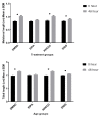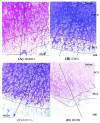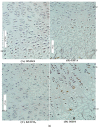Roles of Sodium Hydrogen Exchanger (NHE1) and Anion Exchanger (AE2) across Chondrocytes Plasma Membrane during Longitudinal Bone Growth
- PMID: 35877910
- PMCID: PMC9321928
- DOI: 10.3390/membranes12070707
Roles of Sodium Hydrogen Exchanger (NHE1) and Anion Exchanger (AE2) across Chondrocytes Plasma Membrane during Longitudinal Bone Growth
Abstract
Mammalian long bone growth occurs through endochondral ossification, majorly regulated by the controlled enlargement of chondrocytes at the growth plate (GP). This study aimed to investigate the roles of Na+/H+ (sodium hydrogen exchanger (NHE1)) and HCO3− (anion exchanger [AE2]) during longitudinal bone growth in mammals. Bones from P10 SpragueDawley rat pups were cultured exvivo in the presence or absence of NHE1 and AE2 inhibitors to determine their effect on long bone growth. Gross morphometry, histomorphometry, and immunohistochemistry were used to assess the bone growth. The results revealed that the culture of the bones in the presence of NHE1 and AE2 inhibitors reduces bone growth significantly (p < 0.05) by approximately 11%. The inhibitor significantly (p < 0.05) reduces bone growth velocity and the length of the hypertrophic chondrocyte zone without any effect on the total GP length. The total GP chondrocyte density was significantly (p < 0.05) reduced, but hypertrophic chondrocyte densities remained constant. NHE1 fluorescence signaling across the GP length was higher than AE2, and their localization was significantly (p < 0.05) inhibited at the hypertrophic chondrocytes zone. The GP lengthening was majorly driven by an increase in the overall GP chondrocyte and hypertrophic chondrocyte densities apart from the regulatory volume phenomenon. This may suggest that NHE1 and AE2 could have a regulatory role in long bone growth.
Keywords: chondrocytes; growth plate; long bone growth; plasma membrane inhibitors.
Conflict of interest statement
The authors declare no conflict of interest.
Figures






Similar articles
-
Suppression of mammalian bone growth by membrane transport inhibitors.J Cell Biochem. 2013 Mar;114(3):658-68. doi: 10.1002/jcb.24408. J Cell Biochem. 2013. PMID: 23059814
-
Immunolocalization of anion exchanger AE2, Na(+)/H(+) exchangers NHE1 and NHE4, and vacuolar type H(+)-ATPase in rat pancreas.J Histochem Cytochem. 2001 Apr;49(4):463-74. doi: 10.1177/002215540104900406. J Histochem Cytochem. 2001. PMID: 11259449
-
Na+/H+ exchange is inactivated during mouse oocyte meiosis, facilitating glycine accumulation that maintains embryo cell volume.J Cell Physiol. 2013 Oct;228(10):2042-53. doi: 10.1002/jcp.24370. J Cell Physiol. 2013. PMID: 23553550
-
Chondrocyte hypertrophy in skeletal development, growth, and disease.Birth Defects Res C Embryo Today. 2014 Mar;102(1):74-82. doi: 10.1002/bdrc.21062. Birth Defects Res C Embryo Today. 2014. PMID: 24677724 Review.
-
Role of Genetic Mutations of the Na+/H+ Exchanger Isoform 1, in Human Disease and Protein Targeting and Activity.Mol Cell Biochem. 2021 Feb;476(2):1221-1232. doi: 10.1007/s11010-020-03984-4. Epub 2020 Nov 17. Mol Cell Biochem. 2021. PMID: 33201382 Review.
References
Grants and funding
LinkOut - more resources
Full Text Sources
Miscellaneous

